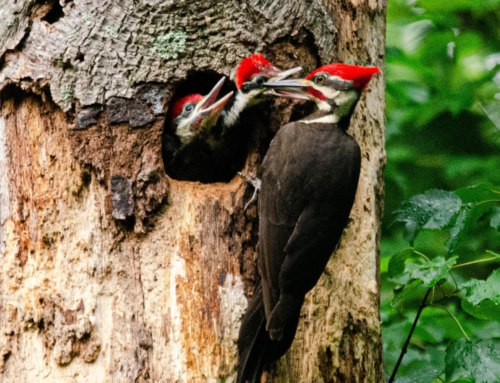The baby birds are out at Tyler!
On June 16th, the 16 participants in the Wednesday weekly bird walk at Tyler recorded 43 species of birds. This is no small feat. June is a relatively quiet month in the birding world. With May comes the wild variety of species on migration, singing birds establishing territories, birds forming pairs and carrying nesting material — surprises every day. In June, song is less frequent, less frenetic. Many migrants have passed through to their nesting grounds further north. The local birds and the migrants that stay have settled into their nesting routines. Except in feeding and territorial defense, birds necessarily remain quiet, hidden. The special joy of birding in June comes from finding evidence that babies are being born; that nesting was successful. On this day, the Wednesday birding group found that evidence of successful nesting was abundant in the Arboretum. The woods and fields were filled with the peeps, chirps and trills unique to this time of the year. They are the sounds of baby birds. We usually can’t see them and shouldn’t try too hard. They are not to be disturbed. We must be content with savoring their sound and what it represents.

Juvenile Eastern Bluebird
But there was still plenty to see. The young bluebirds were out and about; their brown color with spotted back and breast make for an identification challenge until you catch sight of the patches of bluebird-blue on the tail and wings. They will look more like adults as they molt out of this juvenile plumage in August through September.
In the dark woods, we spotted a fledgling wood thrush, its youth made evident by its short stubby tail. The ubiquitous common yellowthroats were flitting around in the meadows hunting for food. Several were carrying insects in their mouths to feed their young. An exception being the one male who was caught in the act of swallowing his spider, prompting a disparaging remark about men from one female birder.

Female common Yellowthroat and male common Yellowthroat
Multiple singing ovenbirds and red-eyed vireos told us things were going well in the woods. We heard the song of the ever-popular scarlet tanager, but unfortunately couldn’t find him. In the meadows, the Eastern towhees were telling us to drink our tea.
We were a happy bunch, but the best was yet to come. As we neared the end of our walk, screaming calls from above led us to a fledgling red-tailed hawk perched high atop a spruce, just down the slope from the Fort Tyler treehouse. Some 30 yards away, directly over the treehouse, an adult red-tail was perched next to an empty nest which was nestled deep inside a tall white pine. The adult was keeping a watchful eye on the fledgling. The “baby” red-tail was the size of an adult and had adult-like plumage, except for its head which was covered by fluffy white feathers, remnants of its natal down. The bird sat on its high perch looking around and calling out its screams as it waited for a parent to bring a meal. Everyone in the group was able to get great looks at the bird through their binoculars and our spotting scope. It was a fine ending to a fulfilling bird walk.
After the walk, I retrieved my camera and returned alone to photograph the young hawk. A mother and her four-year-old daughter who had been exploring the treehouse came down the hill to watch. I handed the little girl my binoculars and with only a little help from Mom, she found the bird and excitedly exclaimed “I see it!”. This then turned out to be the highlight of the day. That moment itself made the bird walks worth their while and so too the treehouses, built to help attract children to Tyler Arboretum with the hope they leave, like this child, having had a valuable experience with nature.

Fledgeling Redtail Hawk






